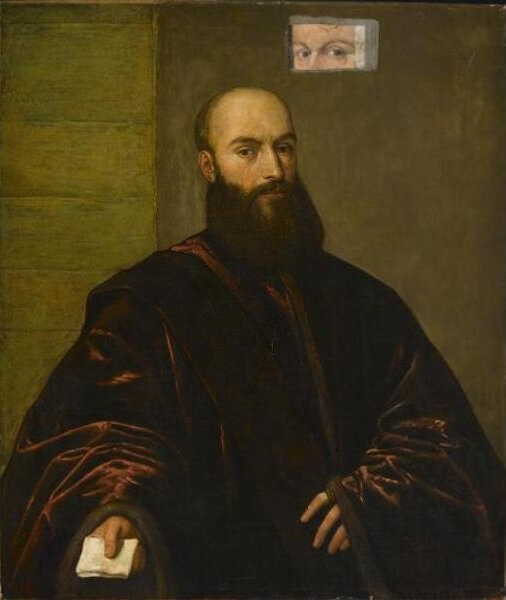Titian's Lady in White loaned to the Norton Simon Museum
Titian (Tiziano Vecellio, Italian, c. 1488/90–1576), Portrait of a Lady in White, c. 1561. Oil on canvas, 102 x 86 cm. Gemäldegalerie Alte Meister, Staatliche Kunstsammlungen Dresden. Photo: Elke Estel/ Hans-Peter Klut.
PASADENA, CA.- The Norton Simon Museum announces a special installation of Titian’s Lady in White, c. 1561, on loan this winter from the Gemäldegalerie Alte Meister in Dresden. This captivating portrait, whose sitter’s identity has eluded scholars for centuries, has been a highlight of Dresden’s art collection for more than 250 years. Its installation at the Norton Simon Museum marks the first time this painting has been on view in Southern California. It hangs in the Museum’s 16th–17th century art wing, near works by the artist’s contemporaries, such as Bellini and Giorgione.
Says Norton Simon Museum President Walter Timoshuk, “It is a great privilege to include in the Museum’s masterpiece exchange program works from the Gemäldegalerie Alte Meister in Dresden, an institution long renowned for its exceptional collection. Titian’s Lady in White is one of their most arresting Venetian pictures, and I know that our visitors will enjoy encountering her gaze in our galleries.”
Adds Gemäldegalerie Alte Meister Director Stephan Koja, “The collection of the Norton Simon Museum is of extraordinary quality, and the setting in this elegant building makes the experience of a visit so memorable. In this regard the Norton Simon Museum is comparable to the Gemäldegalerie Alte Meister, which not only is one of the most famous treasure houses of great European painting but also a Gesamtkunstwerk in its presentation: with the gilded Rococo frames of the pictures and the spectacular building by Gottfried Semper which houses them. We really look forward to the display of one of our paintings in the context of the Norton Simon collection and, in the near future, to the juxtaposition of a masterwork from Pasadena with its contemporaries in Dresden”
Titian (Tiziano Vecellio, ca. 1488–1576) was born in Pieve de Cadore, a small medieval town just south of the Dolomite Mountains, in between the Austrian border and Venice. As a child, he was sent to Venice to become an artist’s apprentice, eventually working under both Gentile and Giovanni Bellini, and alongside Giorgione, all of whom greatly influenced his style and technique. Indeed, within a short period of time Titian established himself as a premier painter to the nobility, church and unique oligarchic republic. His distinctive use of color and light made him a much sought-after master painter, draughtsman and printmaker. His reputation spread internationally across Italy to France and Spain, and further to northern Europe, where commissions came from not only elite private collectors but Popes, Princes, Emperors and Kings.
Titian painted Lady in White in the penultimate decade of his long life. In this sumptuous painting, we see a beguiling young woman, dressed in white satin, bejeweled with gold, precious stones and her finest pearls, holding a ventuolo, a flag-shaped fan. She is spotlighted, and the intensity of the illumination is reflected in her hair, the sheen of the fabric of her dress, and the flush of her cheeks and lips. Her warm, dark brown eyes offset her opalescent skin and gown, and echo the dark terracotta of the mottled background. Her image could almost be seen as a monochromatic impression, save for the punctuation of her evocative red lips, with that demure smile.
Interpretations of this inscrutable picture have been voiced as early as 100 years after Titian executed it, and uncertainty about the sitter still abounds to this day. Is this a portrait of his daughter Lavinia, his illegitimate daughter Emilia, or might she be his mistress? Does it depict a blushing bride on her wedding day? Should it not be considered a traditional portrait, but rather an idealized image depicting the very essence of the beauty and spirit of Venetian women?
Archival documents give us some clues, but no answers. In 1561, Titian himself referred to this painting in a letter to Alfonso II d’Este of Ferrara (1533–1597), saying that the image represented someone very dear to him, “the most precious being” in his life. In an earlier letter to Philip II of Spain, an avid collector of Titian’s work, the artist referred to another version of the painting (now lost), calling the sitter “the absolute mistress of my soul.” Based on these words, the painting was catalogued as early as 1663 in the Este collection as “Titian’s mistress.” Over the centuries, art historians and biographers have speculated on the subject’s identity, but to this day we cannot be certain who this mysterious beauty might be.
Titian’s work was greatly admired by the first owner of this painting, the aforementioned Alfonso II d’Este, who was a prodigious patron of the arts and sciences. King Augustus III of Poland and Elector of Saxony (1696–1763) purchased the painting directly from the Este collection in 1746, and it has remained in the venerable Dresden collections since that time.
The installation of Titian’s Lady in White is organized by Chief Curator Carol Togneri. A series of lectures and related events will be offered in conjunction with its presentation at the Norton Simon Museum.
The Titians in Norton Simon Museum
Titian (Italian, c.1487/90-1576), Portrait of a Man, 16th century. Oil on canvas, 38 x 32 in. (96.5 x 81.3 cm). The Norton Simon Foundation, F.1965.1.064.P. © The Norton Simon Foundation

/https%3A%2F%2Fprofilepics.canalblog.com%2Fprofilepics%2F1%2F0%2F100183.jpg)
/https%3A%2F%2Fstorage.canalblog.com%2F03%2F02%2F119589%2F96711876_o.jpg)
/https%3A%2F%2Fstorage.canalblog.com%2F11%2F31%2F119589%2F94773502_o.jpg)
/https%3A%2F%2Fstorage.canalblog.com%2F20%2F83%2F119589%2F94772815_o.jpg)
/https%3A%2F%2Fstorage.canalblog.com%2F26%2F72%2F119589%2F75604929_o.jpg)
/https%3A%2F%2Fstorage.canalblog.com%2F59%2F60%2F119589%2F26458628_o.jpg)







/image%2F1371349%2F20240412%2Fob_258f9b_ash-ashm-wa2008-89-001.jpg)
/image%2F1371349%2F20240412%2Fob_d5ebdf_10105187116-db17b2f5ff-b.jpg)
/image%2F1371349%2F20240412%2Fob_efd409_dp811857.jpg)
/http%3A%2F%2Fstorage.canalblog.com%2F04%2F81%2F119589%2F128791640_o.jpg)